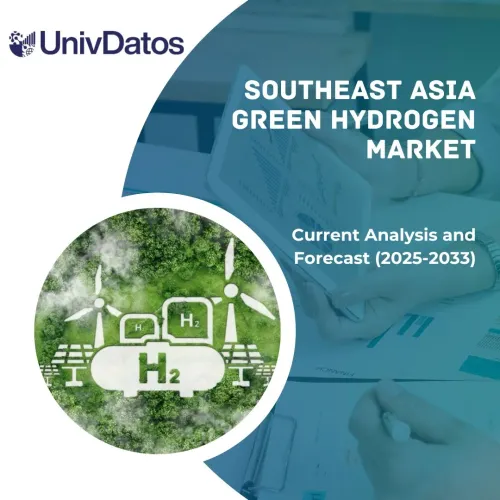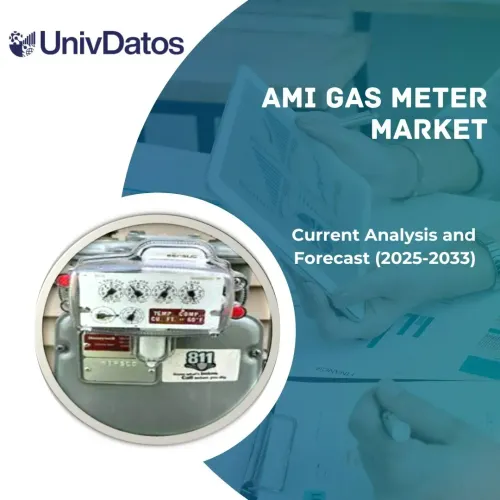- Home
- About Us
- Industry
- Services
- Reading
- Contact Us
Wind Power Market: Current Analysis and Forecast (2023-2030)
Emphasis on P Installation (Onshore and Offshore); Turbine Capacity (Up to 1 MW, 1 MW to 3 MW, 3 MW to 5 MW, and Above 5MW); Application (Utility and Non-Utility); Component (Turbine, Support Structure, Electrical Infrastructure, and Others); Region/Country.
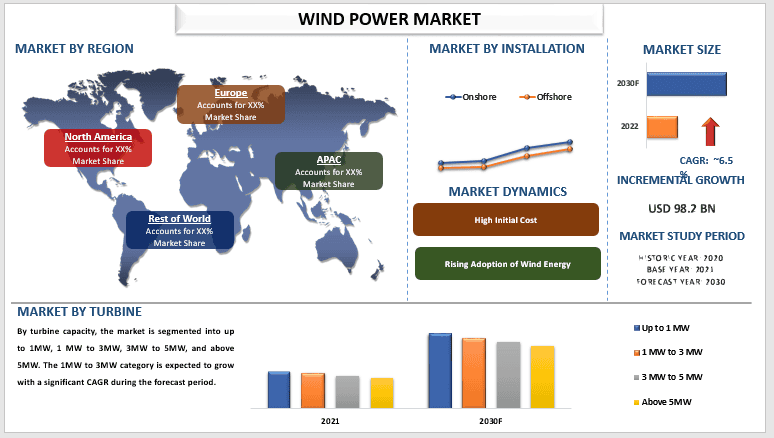
The wind power market was valued at USD 98.2 Billion and is expected to grow at a strong CAGR of around 6.5% during the forecast period (2023-2030). The market is growing with the increasing demand for clean and renewable energy sources. Governments around the world are implementing policies to reduce greenhouse gas emissions and combat climate change, which has led to an increase in investments in wind power projects. Additionally, the cost of wind power has decreased significantly in recent years, making it an increasingly cost-competitive option compared to traditional energy sources like fossil fuels. Furthermore, advancements in technology have led to the development of larger and more efficient wind turbines, making it possible to generate more electricity from the same amount of wind power. Finally, the intermittent nature of wind power can be addressed through the use of energy storage technologies, further increasing its viability as a reliable and sustainable energy source.
Some of the major players operating in the Siemens Gamesa Renewable Energy, S.A.; Suzlon Energy Limited; Vestas; NORDEX SE; Mingyang Smart Energy; GENERAL ELECTRIC; Goldwind; ENVISION GROUP; Zhejiang Windey Co., Ltd.; and SANY Group. Several M&As along with partnerships have been undertaken by these players to facilitate customers with hi-tech and innovative products/technologies.
Insights Presented in the Report
“Amongst installation outlook, the offshore segment to grow with high CAGR during the forecast period”
Based on the installation outlook, the market is bifurcated into onshore and offshore. The offshore segment is anticipated to grow with a significant CAGR during the forecast period. The offshore wind power market is driven by a variety of factors, including the growing demand for clean energy, technological advancements, increasing government support, and decreasing costs. The need to reduce carbon emissions and combat climate change has led to the implementation of policies and regulations that encourage the development of renewable energy sources, including offshore wind power. Governments around the world are providing financial incentives and regulatory support to encourage the development of offshore wind power projects, and the cost of offshore wind power has decreased significantly in recent years, making it increasingly competitive with traditional energy sources. For instance, The Biden Administration has set a goal of deploying 30 GW of offshore wind capacity by 2030, with plans to hold offshore wind lease auctions in the Gulf of Mexico, Mid-Atlantic, and New England.
“Amongst application, the non-utility category to grow with high CAGR during the forecast period”
By application, the market is bifurcated into utility and non-utility. The non-utility category is expected to grow with a high CAGR during the forecast period. The non-utility segment of the wind power market includes large-scale wind power projects that are not connected to the grid, used for electricity generation for remote communities, industrial facilities, and military bases. Several factors, including rising need for reliable and cost-effective energy solutions for remote communities, a surge for energy independence, and increasing demand for renewable energy in industrial and military applications are driving the segmental growth during the forecast period.
“Amongst component, the turbine category to hold a significant share of the market in 2022”
Based on the component, the market is categorized into turbine, support structure, electrical infrastructure, and others. The turbine category held a significant share of the market in 2022. The turbine segment of the wind power market includes the various types of wind turbines used in wind power projects, such as horizontal-axis wind turbines (HAWTs) and vertical-axis wind turbines (VAWTs). Rising technological advancements and increasing investments by companies are some of the major drivers of the segment. Technological advancements in wind turbine technology have led to the development of more efficient and cost-effective wind turbines, with improved performance and durability. For instance, in March 2022, Siemens Gamesa Renewable Energy announced the launch of its newest offshore wind turbine, the SG 14-15.0-MW, which is designed for use in ultra-deepwater environments.
“North America to grow with high CAGR during the forecast period”
North America is anticipated to grow with significant CAGR during the forthcoming years owing to the increase in the demand for clean energy in U driven by government policies and regulations, as well as consumer awareness and preferences. For instance, in August 2021, the US Department of the Interior announced plans to hold offshore wind lease auctions in the Gulf of Mexico and the Atlantic Ocean, with the potential to develop over 4 GW of offshore wind capacity. Moreover, the cost of wind power has decreased significantly in recent years, making it increasingly competitive with traditional energy sources. According to a report by the US Department of Energy, the levelized cost of electricity (LCOE) for wind power has fallen by 70% since 2009.
Wind Power Market Report Coverage
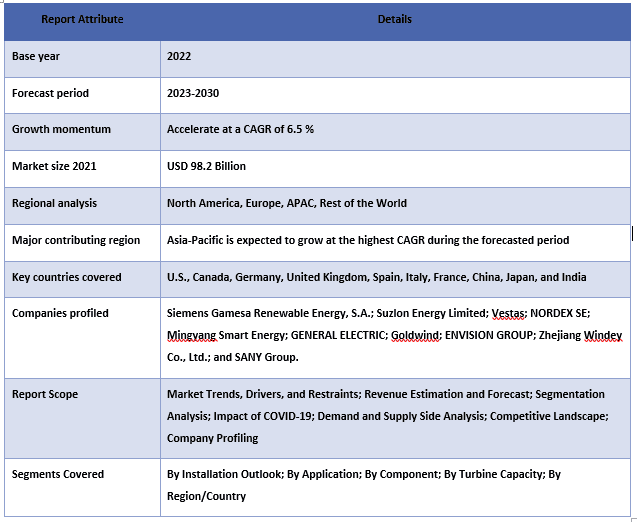
Reasons to buy this report:
- The study includes market sizing and forecasting analysis validated by authenticated key industry experts.
- The report presents a quick review of overall industry performance at one glance.
- The report covers an in-depth analysis of prominent industry peers with a primary focus on key business financials, product portfolios, expansion strategies, and recent developments.
- Detailed examination of drivers, restraints, key trends, and opportunities prevailing in the industry.
- The study comprehensively covers the market across different segments.
- Deep dive regional level analysis of the industry.
Customization Options:
The global wind power market can further be customized as per the requirement or any other market segment. Besides this, UMI understands that you may have your own business needs, hence feel free to connect with us to get a report that completely suits your requirements.
Table of Content
Research Methodology for the Wind Power Market Analysis (2023-2030)
Analyzing the historical market, estimating the current market, and forecasting the future market of the global wind power market were the three major steps undertaken to create and analyze the adoption of wind power in major regions globally. Exhaustive secondary research was conducted to collect the historical market numbers and estimate the current market size. Secondly, to validate these insights, numerous findings and assumptions were taken into consideration. Moreover, exhaustive primary interviews were also conducted, with industry experts across the value chain of the global wind power market. Post assumption and validation of market numbers through primary interviews, we employed a top-down/bottom-up approach to forecasting the complete market size. Thereafter, market breakdown and data triangulation methods were adopted to estimate and analyze the market size of segments and sub-segments of the industry pertains to. Detailed methodology is explained below:
Analysis of Historical Market Size
Step 1: In-Depth Study of Secondary Sources:
Detail secondary study was conducted to obtain the historical market size of the wind power market through company internal sources such as annual reports & financial statements, performance presentations, press releases, etc., and external sources including journals, news & articles, government publications, competitor publications, sector reports, third-party database, and other credible publications.
Step 2: Market Segmentation:
After obtaining the historical market size of the wind power market, we conducted a detailed secondary analysis to gather historical market insights and share for different segments & sub-segments for major regions. Major segments are included in the report as installation outlook, turbine capacity, application, and component. Further country-level analyses were conducted to evaluate the overall adoption of testing models in that region.
Step 3: Factor Analysis:
After acquiring the historical market size of different segments and sub-segments, we conducted a detailed factor analysis to estimate the current market size of the wind power market. Further, we conducted factor analysis using dependent and independent variables such as installation outlook, turbine capacity, application, and component of the wind power market. A thorough analysis was conducted for demand and supply-side scenarios considering top partnerships, mergers and acquisitions, business expansion, and product launches in the wind power market sector across the globe.
Current Market Size Estimate & Forecast
Current Market Sizing: Based on actionable insights from the above 3 steps, we arrived at the current market size, key players in the global wind power market, and market shares of the segments. All the required percentage shares split, and market breakdowns were determined using the above-mentioned secondary approach and were verified through primary interviews.
Estimation & Forecasting: For market estimation and forecast, weights were assigned to different factors including drivers & trends, restraints, and opportunities available for the stakeholders. After analyzing these factors, relevant forecasting techniques i.e., the top-down/bottom-up approach were applied to arrive at the market forecast for 2030 for different segments and sub-segments across the major markets globally. The research methodology adopted to estimate the market size encompasses:
- The industry’s market size, in terms of revenue (USD) and the adoption rate of the wind power market across the major markets domestically
- All percentage shares, splits, and breakdowns of market segments and sub-segments
- Key players in the global wind power market in terms of products offered. Also, the growth strategies adopted by these players to compete in the fast-growing market
Market Size and Share Validation
Primary Research: In-depth interviews were conducted with the Key Opinion Leaders (KOLs) including Top Level Executives (CXO/VPs, Sales Head, Marketing Head, Operational Head, Regional Head, Country Head, etc.) across major regions. Primary research findings were then summarized, and statistical analysis was performed to prove the stated hypothesis. Inputs from primary research were consolidated with secondary findings, hence turning information into actionable insights.
Split of Primary Participants in Different Regions
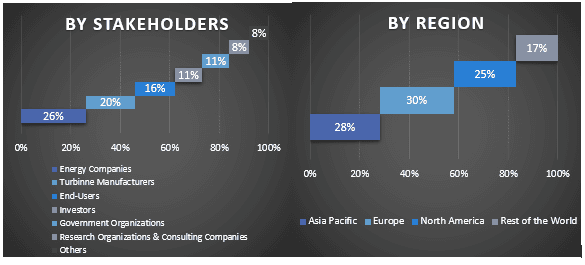
Market Engineering
The data triangulation technique was employed to complete the overall market estimation and to arrive at precise statistical numbers for each segment and sub-segment of the global wind power market. data was split into several segments & sub-segments post studying various parameters and trends in the areas of the installation outlook, turbine capacity, application, and component the global wind power market.
The main objective of the Global Wind Power Market Study
The current & future market trends of the global wind power market were pinpointed in the study. Investors can gain strategic insights to base their discretion for investments on the qualitative and quantitative analysis performed in the study. Current and future market trends determined the overall attractiveness of the market at a regional level, providing a platform for the industrial participant to exploit the untapped market to benefit from a first-mover advantage. Other quantitative goals of the studies include:
- Analyze the current and forecast market size of the wind power market in terms of value (USD). Also, analyze the current and forecast market size of different segments and sub-segments.
- Segments in the study include areas of the installation outlook, turbine capacity, application, and component.
- Define and analysis of the regulatory framework for the wind power
- Analyze the value chain involved with the presence of various intermediaries, along with analyzing customer and competitor behaviors of the industry.
- Analyze the current and forecast market size of the wind power market for the major region
- Major countries of regions studied in the report include Asia Pacific, Europe, North America, and the Rest of the World
- Company profiles of the wind power market and the growth strategies adopted by the market players to sustain in the fast-growing market
- Deep dive regional level analysis of the industry
Related Reports
Customers who bought this item also bought






